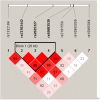Association between MIR31HG polymorphisms and the risk of Lumbar disc herniation in Chinese Han population
- PMID: 35704669
- PMCID: PMC9467585
- DOI: 10.1080/15384101.2022.2087281
Association between MIR31HG polymorphisms and the risk of Lumbar disc herniation in Chinese Han population
Abstract
Lumbar disc herniation (LDH) is a common spinal disease that endangers human health. Genetic factors play a vital role in the progression of LDH. This study aimed to explore the relationship of the MIR31HG polymorphism with LDH risk in the Chinese population. Seven candidate SNPs on MIR31HG in 504 patients with LDH and 503 healthy people were genotyped by Agena MassARRAY platform. Logistic regression was used to calculate the relationship between MIR31HG polymorphism and LDH risk under different genetic models. Multi-factor dimensionality reduction (MDR) analysis was performed to evaluate the SNP-SNP interaction. We found that rs10965059 was significantly associated with a decreased risk of LDH under the dominant (OR = 0.46, 95% CI: 0.34-0.62, P < 0.001), log-additive (OR = 0.59, 95%CI: 0.45-0.76, P < 0.001), and codominant (OR = 0.40, 95%CI: 0.29-0.55, P < 0.001) models in the overall analysis. In the subgroup analyses of age, male, and complications, we found that rs10965059 was associated with a reduced risk of LDH. However, there was no significant correlation between MiR-31HG polymorphisms and risk of LDH in females. In addition, the three SNPs (rs72703442-rs2025327-rs55683539) was mapped to a 26kb LD block with D' >0.96, suggesting a significant linkage disequilibrium presence among each pair SNPs. MDR analysis showed that the best single-locus and multi-locus models for the prediction of LDH risk were rs10965059 and seven-locus models, respectively, and both of them increased LDH risk. Our results shown that in the Chinese Han population, the MIR31HG polymorphism rs10965059 was involved in a risk to symptomatic LDH, which provides a scientific basis for early screening, prevention, diagnosis and treatment of local LDH high-risk populations.
Keywords: Chinese Han population; MIR31HG; case-control study; lumbar disc herniation; single nucleotide polymorphisms.
Conflict of interest statement
No potential conflict of interest was reported by the author(s).
Figures


Similar articles
-
Association of LINC-PINT polymorphisms with lumbar disc herniation risk among Chinese Han population: a case control study.J Orthop Surg Res. 2023 Aug 8;18(1):585. doi: 10.1186/s13018-023-04052-5. J Orthop Surg Res. 2023. PMID: 37553573 Free PMC article.
-
MIR31HG polymorphisms are related to steroid-induced osteonecrosis of femoral head among Chinese Han population.BMC Musculoskelet Disord. 2022 Sep 3;23(1):836. doi: 10.1186/s12891-022-05785-w. BMC Musculoskelet Disord. 2022. PMID: 36057712 Free PMC article.
-
Association of GSDMC polymorphisms with lumbar disc herniation among Chinese Han population.Int J Immunogenet. 2020 Dec;47(6):546-553. doi: 10.1111/iji.12488. Epub 2020 Apr 24. Int J Immunogenet. 2020. PMID: 32333499
-
Association of glypican-6 polymorphisms with lumbar disk herniation risk in the Han Chinese population.Mol Genet Genomic Med. 2019 Jul;7(7):e00747. doi: 10.1002/mgg3.747. Epub 2019 May 20. Mol Genet Genomic Med. 2019. PMID: 31111662 Free PMC article.
-
RAB40C gene polymorphisms rs62030917 and rs2269556 are associated with an increased risk of lumbar disc herniation development in the Chinese Han population.J Gene Med. 2021 Apr;23(4):e3252. doi: 10.1002/jgm.3252. Epub 2021 Mar 17. J Gene Med. 2021. PMID: 32656896
Cited by
-
Knockdown of MIF-AS1 Inhibits Pain and Inflammation in Lumbar Disc Herniation by Modulating the miR-185-5p/VEGFA Axis.Global Spine J. 2025 Jun 3:21925682251336711. doi: 10.1177/21925682251336711. Online ahead of print. Global Spine J. 2025. PMID: 40460143 Free PMC article.
-
Association of LINC-PINT polymorphisms with lumbar disc herniation risk among Chinese Han population: a case control study.J Orthop Surg Res. 2023 Aug 8;18(1):585. doi: 10.1186/s13018-023-04052-5. J Orthop Surg Res. 2023. PMID: 37553573 Free PMC article.
-
Incidence of and risk factors for lumbar disc herniation with radiculopathy in adults: a systematic review.Eur Spine J. 2025 Jan;34(1):263-294. doi: 10.1007/s00586-024-08528-8. Epub 2024 Oct 25. Eur Spine J. 2025. PMID: 39453541 Free PMC article.
-
MIR31HG, a potential lncRNA in human cancers and non-cancers.Front Genet. 2023 Aug 10;14:1145454. doi: 10.3389/fgene.2023.1145454. eCollection 2023. Front Genet. 2023. PMID: 37636269 Free PMC article. Review.
References
-
- Han L, Zhao P, Guo W, et al. Short-term study on risk-benefit outcomes of two spinal manipulative therapies in the treatment of acute radiculopathy caused by lumbar disc herniation: study protocol for a randomized controlled trial. Trials. 2015;16. DOI: 10.1186/s13063-015-0634-0 - DOI - PMC - PubMed
-
- Chen B-L, Guo J-B, Zhang H-W, et al. Surgical versus non-operative treatment for lumbar disc herniation: a systematic review and meta-analysis. Clin Rehabil. 2018;32:146–160. - PubMed
-
- Rajasekaran S, Bajaj N, Tubaki V, et al. ISSLS prize winner: the anatomy of failure in lumbar disc herniation. Spine (Phila Pa 1976). 2013;38:1491–1500. - PubMed
MeSH terms
Substances
LinkOut - more resources
Full Text Sources
Medical
Research Materials
